Serving 238 students in grades Prekindergarten-12, Metro School ranks in the bottom 50% of all schools in North Carolina for overall test scores (math proficiency is bottom 50%, and reading proficiency is bottom 50%).
The percentage of students achieving proficiency in math is 10-14% (which is lower than the North Carolina state average of 51%). The percentage of students achieving proficiency in reading/language arts is 11-19% (which is lower than the North Carolina state average of 50%).
The student:teacher ratio of 6:1 is lower than the North Carolina state level of 15:1.
Minority enrollment is 82% of the student body (majority Black), which is higher than the North Carolina state average of 57% (majority Black and Hispanic).
Quick Stats (2025)
- School Type: Special education school
- Grades: Prekindergarten-12
- Enrollment: 238 students
- Student:Teacher Ratio: 6:1
- Minority Enrollment: 82%
- Graduation Rate: ≤20% (Btm 50% in NC)
- Overall Testing Rank: Bottom 50%
- Math Proficiency: 10-14% (Btm 50%)
- Reading Proficiency: 11-19% (Btm 50%)
- Science Proficiency: ≤20% (Btm 50%)
- Source: National Center for Education Statistics (NCES), NC Dept. of Education
Top Rankings
Metro School ranks among the top 20% of public schools in North Carolina for:
Category
Attribute
Diversity
Community Size
Student Attention
School Overview
Metro School's student population of 238 students has stayed relatively flat over five school years.
The teacher population of 38 teachers has stayed relatively flat over five school years.
School Type
Grades Offered
Grades Prekindergarten-12
Total Students
238 students
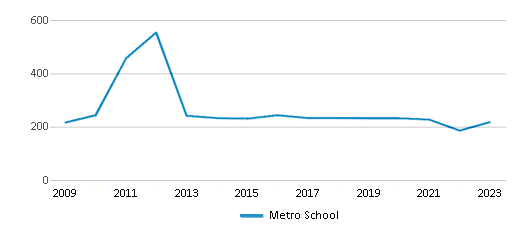
Gender %
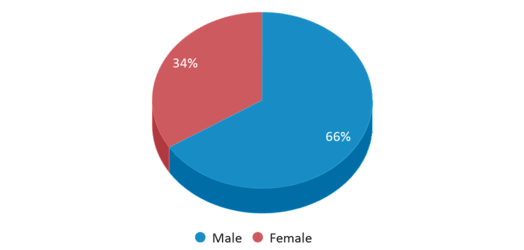
Total Classroom Teachers
38 teachers
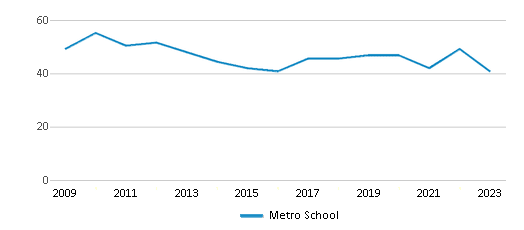
Students by Grade
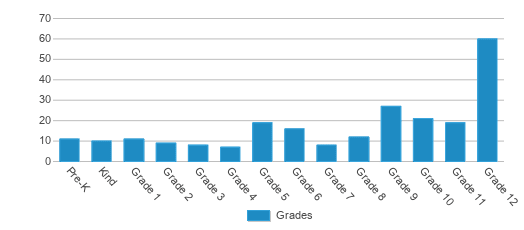
School Rankings
Metro School ranks within the bottom 50% of all 2,617 schools in North Carolina (based off of combined math and reading proficiency testing data).
The diversity score of Metro School is 0.68, which is less than the diversity score at state average of 0.71. The school's diversity has stayed relatively flat over five school years.
Overall Testing Rank
#2575 out of 2617 schools
(Bottom 50%)
(Bottom 50%)
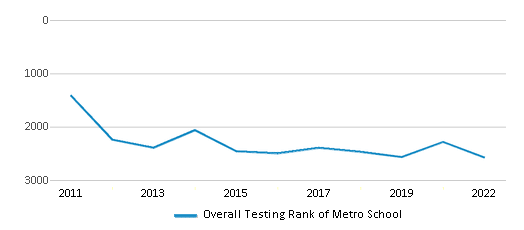
Math Test Scores (% Proficient)
10-14%
51%
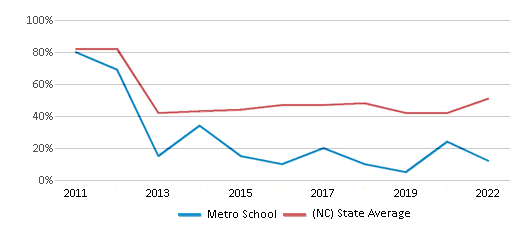
Reading/Language Arts Test Scores (% Proficient)
11-19%
50%
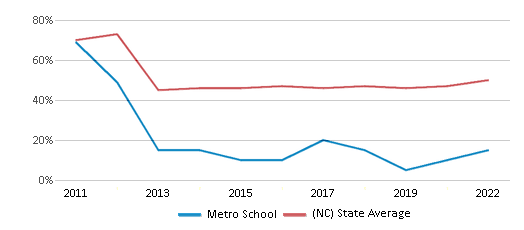
Science Test Scores (% Proficient)
≤20%
63%
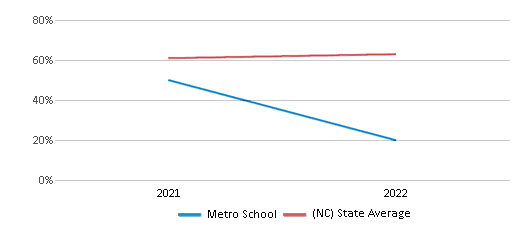
Student : Teacher Ratio
6:1
15:1
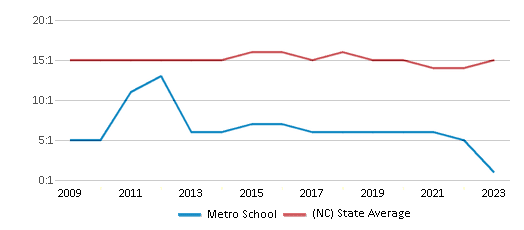
American Indian
n/a
1%
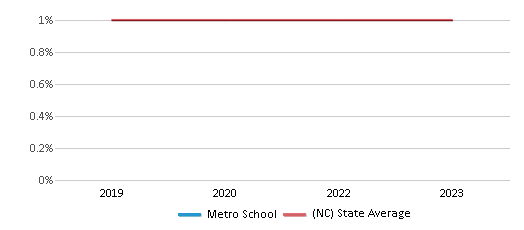
Asian
5%
4%
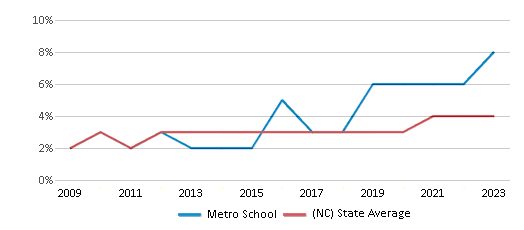
Hispanic
30%
21%
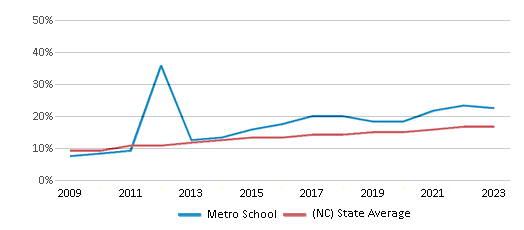
Black
45%
25%
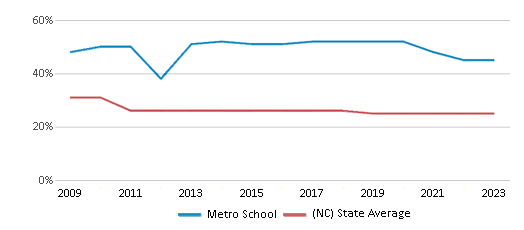
White
18%
43%
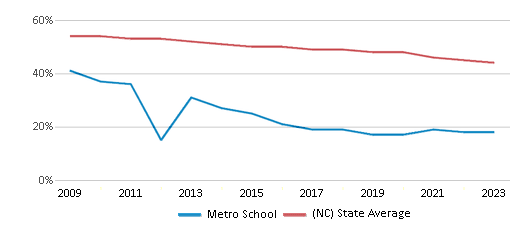
Hawaiian
n/a
n/a
Two or more races
2%
6%
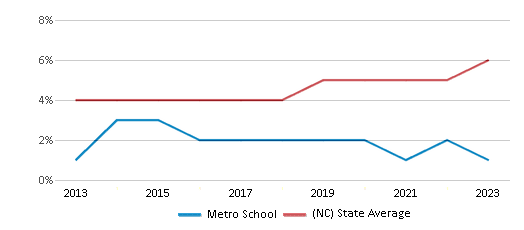
All Ethnic Groups
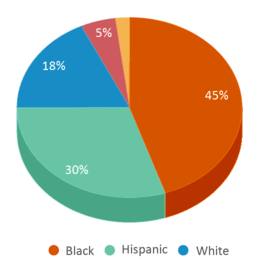
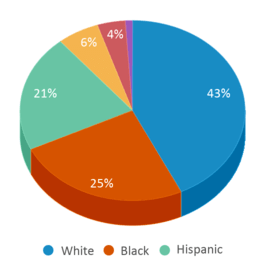
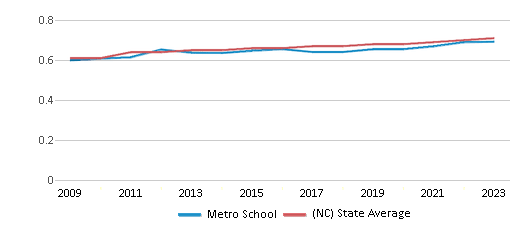
Graduation Rate
≤20%
86%
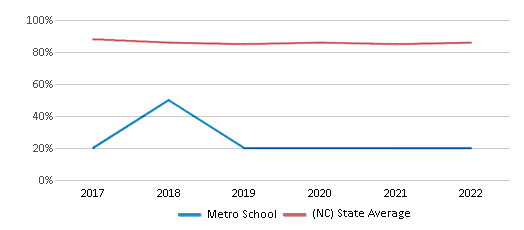
Participates in the National School Lunch Program (NSLP)
Yes
Eligible for Free Lunch
99%
68%
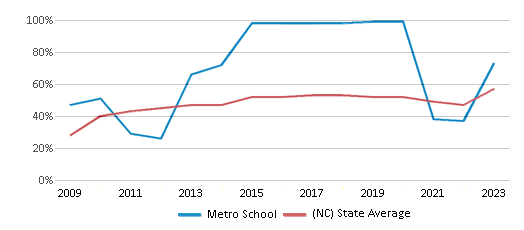
Eligible for Reduced Lunch (20-21)
1%
3%
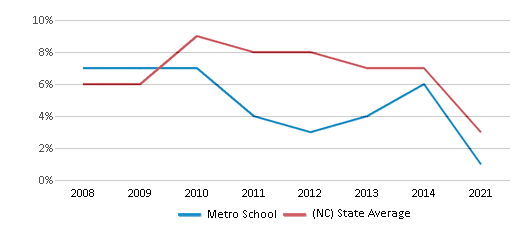
School Statewide Testing
School District Name
Source: National Center for Education Statistics (NCES), NC Dept. of Education
Frequently Asked Questions
What is Metro School's ranking?
Metro School is ranked #2575 out of 2,617 schools, which ranks it among the bottom 50% of public schools in North Carolina.
What schools are Metro School often compared to?
Metro Schoolis often viewed alongside schools like Charlotte-mecklenburg Academy by visitors of our site.
What percent of students have achieved state testing proficiency in math and reading?
10-14% of students have achieved math proficiency (compared to the 51% NC state average), while 11-19% of students have achieved reading proficiency (compared to the 50% NC state average).
What is the graduation rate of Metro School?
The graduation rate of Metro School is 20%, which is lower than the North Carolina state average of 86%.
How many students attend Metro School?
238 students attend Metro School.
What is the racial composition of the student body?
45% of Metro School students are Black, 30% of students are Hispanic, 18% of students are White, 5% of students are Asian, and 2% of students are Two or more races.
What is the student:teacher ratio of Metro School?
Metro School has a student ration of 6:1, which is lower than the North Carolina state average of 15:1.
What grades does Metro School offer ?
Metro School offers enrollment in grades Prekindergarten-12
What school district is Metro School part of?
Metro School is part of Charlotte-Mecklenburg Schools School District.
In what neighborhood is Metro School located?
Metro School is located in the Charlotte center city neighborhood of Charlotte, NC. There are 2 other public schools located in Charlotte center city.
School Reviews
5 8/26/2019
Metro School is CMS'' only separate school. We serve students who are medically fragile and students who have Autism, Down Syndrome, Cognitive Disabilities, Behavior Disorders, etc... We teach our students using the total communication approach. Our teachers teach all academic areas aligned with the adapted common core state standards. Our classrooms are observed frequently and we are to be teaching rigorously at all times.
Review Metro School. Reviews should be a few sentences in length. Please include any comments on:
- Quality of academic programs, teachers, and facilities
- Availability of music, art, sports and other extracurricular activities
Recent Articles

Teaching in Contemporary Times
We explore why individuals choose teaching, illuminating intrinsic motivations, the influence of role models, the pursuit of lifelong learning, and the aspiration to impact society.
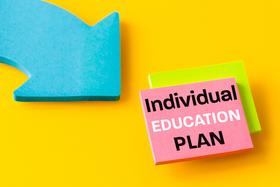
Demystifying IEPs
Unlock the power of Individualized Education Programs (IEPs) in this comprehensive guide. Discover how IEPs support students with diverse needs, including behavioral challenges. This article is a must-read for parents navigating the education system and aspiring teachers seeking to make a positive impact.

December 16, 2024
Personalized Learning: Revolutionizing Education for the 21st CenturyExplore the revolutionary approach of Personalized Learning in K-12 education. This article discusses the benefits, challenges, and potential of tailoring education to individual student needs, incorporating technology and adaptive learning methods to prepare students for the 21st century.





